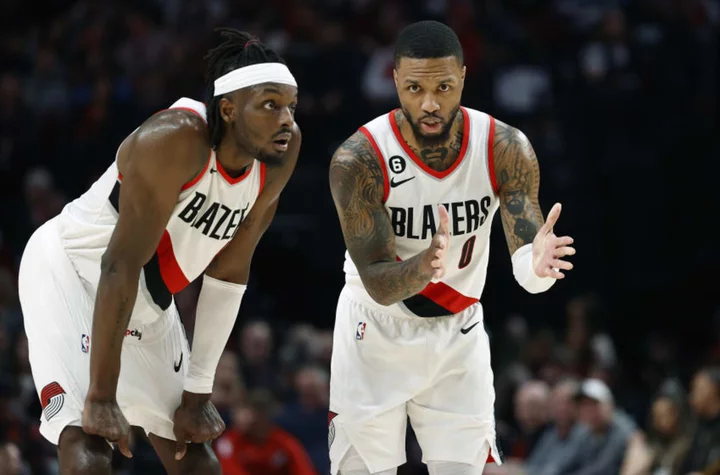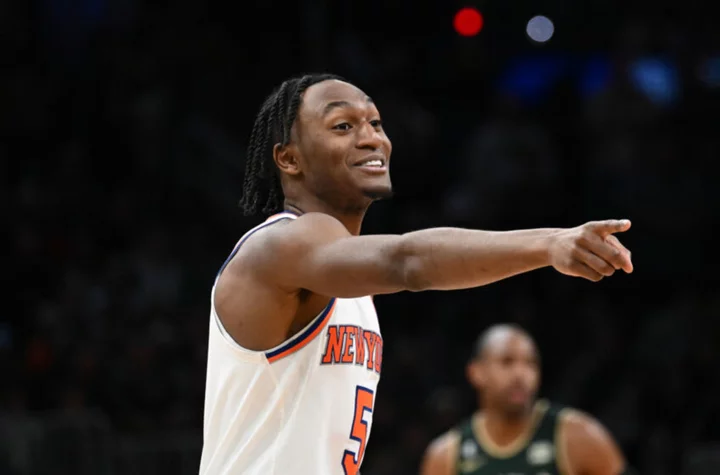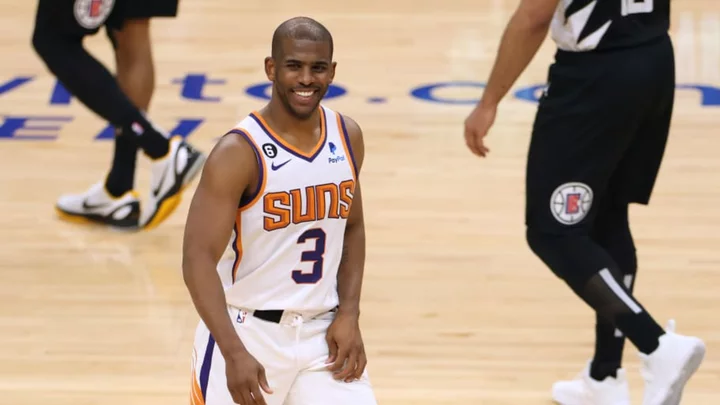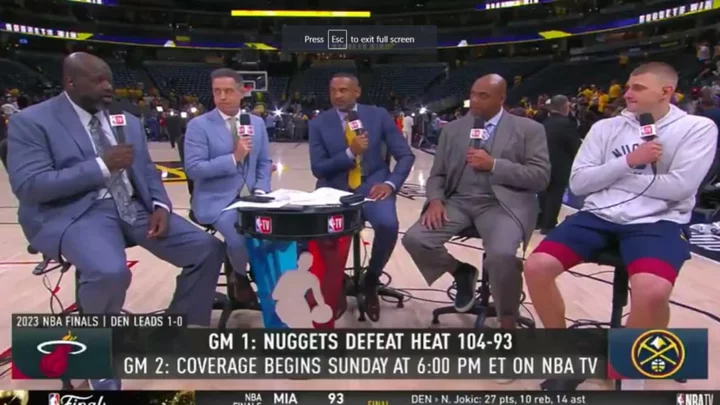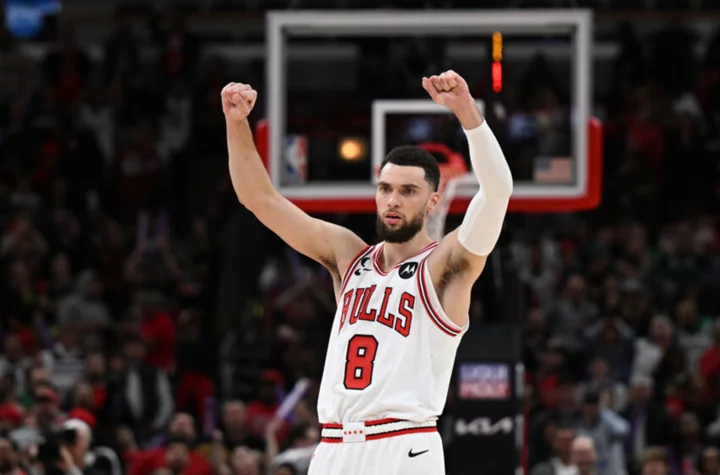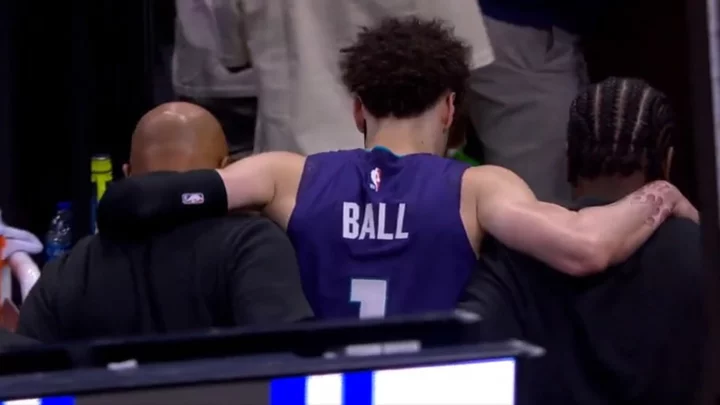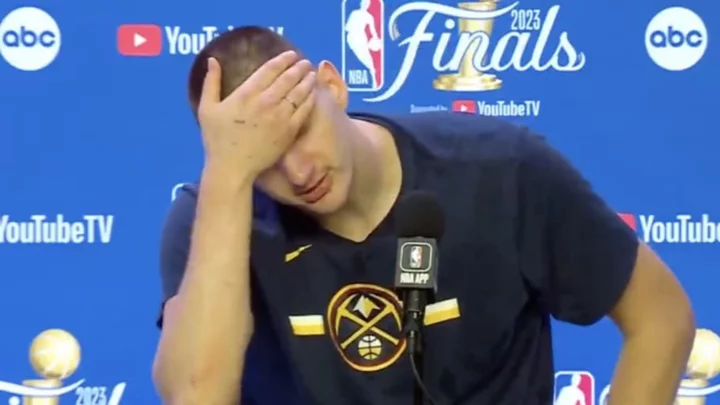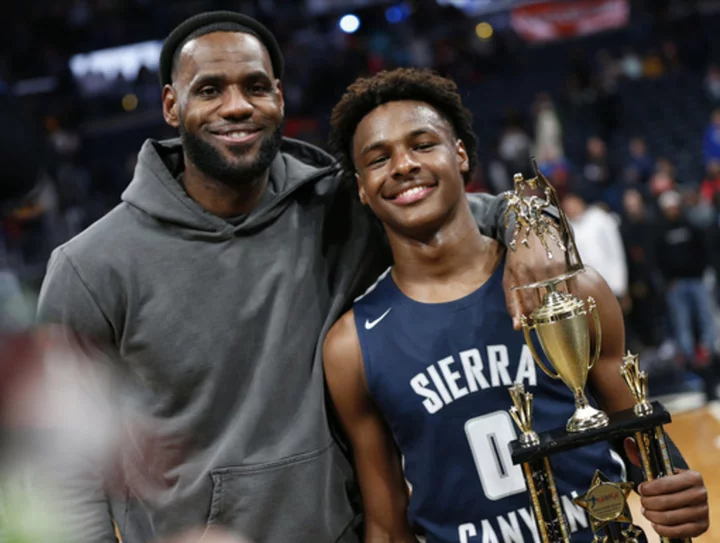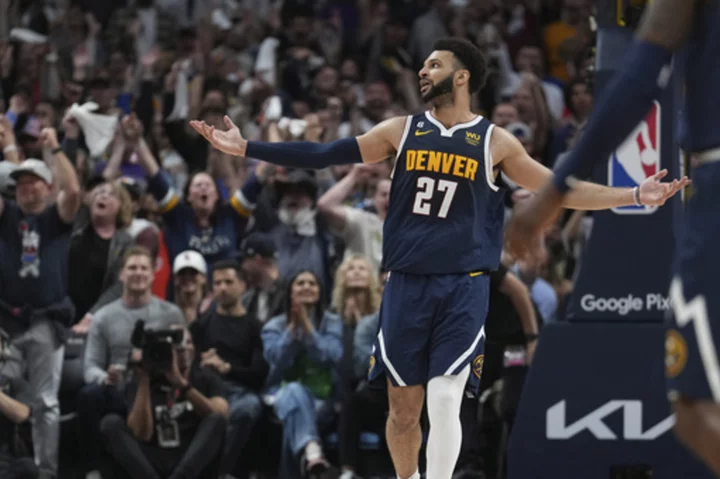The Portland Trail Blazers spent all summer half-trying to convince Damian Lillard to stay. The team spent $160 million to keep Jerami Grant around. That's a win-now move. Crucially, however, the Blazers also kept the No. 3 pick in June's NBA Draft and used it on Scoot Henderson, a point guard.
That was the turning point. Lillard requested a trade to Miami before fans even had time to celebrate Henderson. Since then, it has been months of stony silence, with Lillard refusing to openly criticize the organization and the Blazers refusing to stoop to the level of Miami's shoddy trade package.
With just over a month until training camp, one of two things will happen: Portland will get serious about trading Lillard, probably to Miami, or the Blazers will ask Lillard to report to camp. Aaron J. Fentress of the Oregonian reports that Lillard "would show up" if Portland doesn't strike a deal before the start of camp on Oct. 3.
That could get awkward fast, but Joe Cronin and the Blazers front office have projected an image of strength in this time of great turmoil. The Blazers aren't going to send away their franchise pillar for a bag of candy. It will require an offer legitimately in line with Lillard's value as a top-20 NBA player.
If Lillard sticks around, then the team will try to win as many games as possible and hope against hope to restore the relationship. Lillard has a deep love for the Portland community and he has been a prophet of his own loyalty to the Blazers for the last decade. If any star and team can actually build back trust and find harmony, it's probably these two.
If Lillard doesn't stick around, then it will be full-on tank season for Portland. The Blazers have a fantastic foundation with Henderson, Anfernee Simons, and Shaedon Sharpe, but Portland won't win many games without Lillard. Time to Flunk for Flagg, or something like that.
Chauncey Billups hasn't reached the point of a hot seat, but his performance as Portland's head coach has been a matter of debate pretty much since day one. If the Blazers truly embark on a rebuild, one has to imagine Billups' future with the team would come into sharper focus as the front office attempts to build the right team with the right habits for winning down the road.
Here's what the Blazers are working with rotationally.
Portland Trail Blazers starting point guard: Damian Lillard
There's a reason the Blazers don't really want to trade Lillard. The front office made the best choice for the franchise in selecting Henderson on draft night, but that move was not meant as a rebuke of Lillard. Portland has a lot of guards on the roster, but there's every reason to believe Henderson and Lillard would (or will) function well together.
Last season was the best individual campaign of Lillard's remarkable career. He averaged 32.2 points, 4.8 rebounds, and 7.3 assists on .463/.371/.914 splits in 36.3 minutes. Long commended for his deadly pull-up jumper and endless 3-point range, the overarching breadth of Lillard's talent tends to get underrated. He's an effective slasher with a spritely first step and the playmaking acumen to pick apart overzealous defenses.
Even as Lillard ages, he should be able to maintain elite production because of his shooting and basketball I.Q. He can stick a jumper over any defender with quick, compact mechanics. His shot versatility should lead to productive off-ball work if Lillard ever commits to a more diverse approach. He's ball-dominant right now, but in a magical alternate timeline where the Blazers get to keep Lillard, Henderson is the perfect playmaker to age into stardom as Lillard ages out of his prime and into a more complementary role.
The defense remains a point of concern for Lillard, who is 6-foot-3 and not particularly determined to get stops. That's in part due to the size of his offensive burden in recent years. From a basic preservation statement, it's probably smart for Lillard to get in reps with other ball-handlers for that reason too. Maybe Henderson would allow Lillard to expend more effort on the defensive end.
At the end of the day, however, Lillard's probably on his way out the door. Probably sooner than later.
Primary backup point guard: Scoot Henderson
Scoot Henderson will start sooner than later, whether it's in place of Lillard or (more improbably) beside Lillard. The Blazers could have appeased a publicly restless Lillard by trading the No. 3 pick, but there was simply no way to recoup value similar to Henderson. He's a future face of the franchise and one of the best point guard prospects in recent memory.
The "No. 3 pick" label will probably lead to Henderson being underrated. This was an especially talented draft class, especially at the top. Henderson would have been the No.1 pick in a more standard draft class. Take 2022's class, for example. Chet Holmgren and Paolo Banchero were unique, intriguing prospects, but neither reaches the same heights as Henderson as a prospect.
At 6-foot-3, Henderson is blessed with the strength of professional MMA fighter. He can absorb contact and dish out punishment in a way few teenaged point guards can. Put a slighter guard in Henderson's path and he can bully his way to the rim. Combat his strength with a burlier wing, and Henderson's deadly first step and quick-twitch athleticism will make life extremely difficult on the opposition.
Henderson battled inefficiency with the G-League Ignite, but he's a competent three-level scorer. His pull-up jumper is money from mid-range and there's every reason to believe his 3-point shooting will follow suit. Sharing the court with other quality guards could do Henderson a lot of good. Station him away from the ball, and he's still going to wreak havoc as a slasher and connective playmaker.
Other players who could receive minutes at point guard: Anfernee Simons
Portland Trail Blazers starting shooting guard: Anfernee Simons
There is such thing as too much of a good thing in the NBA. The Blazers have several small-ish guards in the mix right now. Odds are the inevitable Dame trade removes a very prominent figure from that mix, but there's still a question of how successful the team can be with Scoot Henderson and Anfernee Simons — both 6-foot-3, both at or below average on defense — as heads of the hydra.
Still, Simons took another major leap last season despite Lillard's return to the lineup. The IMG Academy product averaged 21.1 points and 4.1 assists on .447/.377/.894 splits in 35.0 minutes. He toggled effortlessly between on-ball and off-ball duties, frequently thriving as a catch-and-shoot threat or slasher next to Dame while anchoring the non-Dame minutes with the second unit.
A similar staggering of roles will probably develop between Simons and Henderson. Henderson is stronger and should ultimately prove much better than Dame on the defensive end, which should dissolve some concerns about Simons' place in the lineup. Simons probably gets underrated in the Tyler Herro/Tyrese Maxey tier of undersized, score-first guards. He's the best playmaker out of that group and, with a 6-foot-9 wingspan, there's time for him to develop into the best defender, too.
With five NBA seasons under his belt, Simons is still only 24 years old. He's on the upswing, making extreme progress with each passing season. With the obvious exception of Dame if he sticks around longer than expected, there's a strong chance Simons will be Portland's best player next season. He has earned that level of confidence from his coaches and his teammates. That Blazers' offense is going to have explosive potential.
Primary backup shooting guard: Matisse Thybulle
The Blazers matched Matisse Thybulle's three-year, $33 million offer sheet from the Dallas Mavericks to keep the two-time All-Defensive wing in Portland. Thybulle's offensive limitations persist, but he shot a very encouraging 38.8 percent on 3.9 attempts per game from 3-point range with the Blazers last season.
Thybulle was consistently gun-shy in Philadelphia. His trade to Portland came with elevated confidence from his teammates and an offense not built around the post-heavy stylings of Joel Embiid. If Thybulle can keep his 3-point numbers up while continuing to stockpile deflections on the defensive end, he's going to play up to his contract.
Up next for Thybulle is diversifying his offensive output. He's a jumpy athlete who flashes on cuts to the rim, but if he can combine a decent 3-point shot with enough ball control to beat errant closeouts as a straight-line driver, then the Blazers are cooking with grease.
Other players who could receive minutes at shooting guard: Shaedon Sharpe, Scoot Henderson, Keon Johnson
Portland Trail Blazers starting small forward: Shaedon Sharpe
Shaedon Sharpe's impressive rookie season contributes to the "too many cooks in the kitchen" nature of Portland's lineup. He's another guard with less than stellar defensive credentials. He's 6-foot-6, but slight of build with a lot of learning to do. Such is life with 20-year-old guards in the NBA, though, and Sharpe has more than earned his spot in the starting five.
Sharpe's rookie season in Portland was a revelation. He was highly regarded coming out of Kentucky, but he never played a game for the Wildcats. He was a relative unknown compared to his lottery pick counterparts, reliant on high school tape and highlight reels to build his case instead of a college resume or international experience. The Blazers took the plunge anyway; Sharpe was the No. 7 pick and he appeared in 80 games (15 starts) in year one.
His role started small, but by year's end — with Lillard, fittingly, shut down — Sharpe was starting games and staking out a weekly claim on the SportsCenter Top 10. The NBA is filled with nutty athletes but Sharpe feels truly singular. He floats like a cloud and frequently climbs several stairs too high on his way up to the rim. Sharpe's athleticism yields more than highlights, too. He's a bursty slasher who can finish with finesse just as well as with power. He's also a competent shooter with untapped potential as a creator.
It's mesmerizing to watch Sharpe bounce around the perimeter, jerking defenders sideways with step-backs or hesitation moves before gutting the defense with a strong move to the rim. His pull-up jumpers are smooth and he shot 36.0 percent on 3.5 attempts per game from 3-point range (in only 22.2 minutes) as a rookie. He has room to grow as a passer and defender, but the foundation is strong and the Blazers, on the precipice of a rebuild, can afford to be patient. Not that Sharpe will require too much patience at this rate.
Primary backup small forward: Nassir Little
Nassir Little re-upped with the Blazers on a four-year, $28 million contract. That's great value for Portland, with Little emerging as a key role player due to his physical wing defense and bankable jumper. He shot 36.7 percent from 3-point range last season, a new career high.
Little is a physical athlete, 6-foot-5 with 220 pounds of pure muscle. He can guard all over the floor thanks to his 7-foot-2 wingspan and he is Portland's best answer to bigger wing creators like LeBron James or Kawhi Leonard. He brings a necessary edge to the second unit and he's still 23 years old, only in the hatchling stage of his NBA career. There's plenty of room to grow beyond what his small contract suggests.
Other players who could receive minutes at small forward: Jerami Grant, Matisse Thybulle, Kris Murray
Portland Trail Blazers starting power forward: Jerami Grant
The Blazers handed Jerami Grant a massive five-year, $160 million contract early in free agency. That came as a shock to everyone. It's clear Portland was trying to convince Dame to stick around with splashy moves, but re-signing Grant for a king's ransom evidently didn't do the trick. Now, Grant will start the eventual non-Dame era as Portland's highest-paid player.
Grant has prioritized money over winning before with the Pistons. There's nothing wrong with that. The man got his bag, and that's good for him. Grant plays both ends of the floor and he has prior experience as 'the guy' in a rebuilding situation. It won't be quite the same in Portland — Scoot, Simons, and Sharpe are all very talented and could soon surpass Grant in the hierarchy of NBA stardom — but Grant will show up to work and produce. Will he play up to that contract? Probably not, but think of him as a slightly superior version of Tobias Harris in Philadelphia. There's honor in that.
At 6-foot-8, Grant will essentially function as the Blazers' defensive anchor. With a number of holes on the perimeter and a rapidly aging man in the middle in Jusuf Nurkic, the Blazers will rely extensively on Grant's ability to cover ground. He's a genuine five-position defender, capable of sliding his feet with guards on the perimeter or using his 7-foot-3 wingspan to deter shots in the paint.
On the offensive end, Grant is more productive than he gets credit for. He averaged 20.5 points on .474/.401/.813 splits in 35.7 minutes last season. He doesn't offer much as a passer, but Grant spaces the floor, moves without the ball, and attacks off the catch with regular success.
Primary backup power forward: Kris Murray
The Blazers selected Kris Murray — twin brother of Kings All-Rookie forward Keegan Murray — with the No. 23 pick in June's NBA Draft. It's not terribly common for rookies at the back end of the first round to become immediate rotation staples, but Murray is already 23 years old and the Blazers are fast-tracking a rebuild in the near future. Expect him to get minutes in a relatively shallow frontcourt.
Murray's appeal is similar to his brother's on the surface. He's 6-foot-8 with smooth 3-point mechanics, strong role player instincts, and a desire to compete. He's not the most versatile athlete, but Murray can defend his position. On the offensive end, he's going to provide value as a spacer, cutter, and generally high-I.Q. connector. He doesn't have the same dynamism as his brother off the dribble, but Portland won't want Murray freestyling very often anyway.
Other players who could receive minutes at power forward: Jabari Walker, Nassir Little, Matisse Thybulle
Portland Trail Blazers starting center: Jusuf Nurkic
Jusuf Nurkic's days in Portland are numbered. He has three years and roughly $53 million left on his contract — not exactly easy-to-swallow trade bait for opposing front offices — but the Blazers are quickly approaching a rebuild and Nurkic is quickly losing effectiveness. The Bosnian Beast didn't look his typical beastly self last season, struggling to defend in space and getting played off the floor in important moments.
Portland's best center last season was Drew Eubanks. Tenure and contract kept Nurkic tethered to the starting role and 26.8 minutes per game, but the Blazers regularly went to Eubanks in closing lineups. It's probably too early to claim the 29-year-old Nurkic is over the hill, but injuries have taken a clear toll and the style of today's game doesn't always favor his specific approach.
Nurkic's season wasn't a complete bust. He still averaged 13.3 points, 9.1 rebounds, and 2.9 assists on .519/.361/.661 splits. He averaged 2.3 attempts per game from 3-point range, a new high-water mark for his career. Nurkic is making attempts to modernize and he's a nifty passer for his position, offering utility beyond the brute-force benefits of his strength in the paint.
That said, the defense is an increasingly major concern. Not long ago, Nurkic could have been appropriately considered one of the best, most underrated defensive anchors in basketball. Not last season. He's still a hulking 6-foot-11, 290-pound presence in the paint, but he's easily exploited when forced to defend outside the restricted area.
Primary backup center: Jerami Grant
It's hard to imagine the Blazers not looking to add another center to the roster before the regular season starts. Eubanks left in free agency and wasn't really replaced. Portland has two unproven bigs on two-way contracts — John Butler Jr. and Ibou Badji — but neither should be penciled into significant minutes, even if the Blazers embrace the tank. Grant is big and rangy enough to moonlight as a small-ball five.
Other players who could receive minutes at center: Jabari Walker, John Butler Jr., Ibou Badji
Jabari Walker is another strong candidate to eat backup center minutes if Portland enters the season without signing or trading for another big. He's 6-foot-9 with broad shoulders, flashes of 3-point shooting, and a physical driving style. He's more four than five, but the Blazers are short on options right now and Walker has experience with the team.

